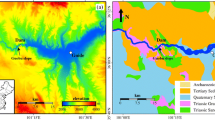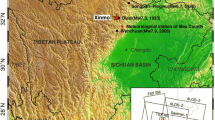Abstract
Over the last decade, Fengcheng oil field rich in heavy oil geological reserves has had a broad prospect of exploration. The reservoirs are mainly composed of high porosity, high permeability sandstone and conglomerate in study area. The reservoir characteristics led to poor fluid and gas injection causing ground surface deformation with the injection of gas and fluid and threatened the safety of nearby construction facilities. Interferometric Synthetic Aperture Radar (InSAR) technology has been used to identify ground surface deformation with high precision, which is widely used in various fields. This paper adopted Small Baseline Subset InSAR (SBAS-InSAR) method to monitor oil field for the period of February 2007 to September 2010. In this study, the Fengcheng oil field in Xinjiang served as an example; we measured subsurface fluid and gas injection-induced ground surface deformation by SBAS-InSAR technique and investigated the causes of observed deformation. The results showed significant uplift over Fengcheng oil field and testified the feasibility of SBAS-InSAR method. The Phased Arrary L-band Synthetic Aperture Radar (PALSAR) datasets outcome revealed ground surface maximum cumulative uplift for 4 years was 40 cm in the line of sight (LOS) direction, and annual average deformation rates were ranging from − 80 to 120 mm/year. Further, the time series analysis based on monitoring results found that the causes of ground surface uplift were related to the increase in pore pressure under the reservoir, and the surface deformation area corresponded to the production well position of study area. Therefore, InSAR technique is an essential tool for the ground surface deformation monitoring due to fluid and gas injection in heavy oil field, ensuring the safety of personnel and property.









Similar content being viewed by others
References
Bai, S. (2008). Master of structural interpretation and reservoir research in Fengting Oilfield Master, Institute of Technology Guilin University of Technology.
Berardino, P., Fornaro, G., Lanari, R., & Sansosti, E. (2002). A new algorithm for surface deformation monitoring based on small baseline differential SAR interferograms. IEEE Transactions on Geoscience and Remote Sensing, 40(11), 2375–2383.
Chen, B., Liu, Y., Liu, H., Chen, Z., Wen, G., & Shi, J. A. (2015). Reservoir characteristics and evaluation of the permian Xiazijie formation in Wuerhe, Junggar Basin. Lithologic Reservoirs, 27(4), 53–60.
Del Conte, S., Tamburini, A., Higgs, A., Morgan, J., Falorni, G., & Banwell, M.-J. (2015). PS insar monitoring in heavy oil operations. IEEE Transactions on Geoscience and Remote Sensing, 99, 1–11.
Edmunds, R. C., Gill, J. A., Baldwin, D. H., Linbo, T. L., French, B. L., Brown, T. L., Esbaugh, A. J., Mager, E. M., Stieglitz, J., Hoenig, Benetti, D., Grosell, M., Scholz, N. L. & Incardona, J. P. (2015). Corresponding morphological and molecular indicators of crude oil toxicity to the developing hearts of mahi mahi. Scientific Reports 5.
Fielding, E. J., Blom, R. G., & Goldstein, R. M. (1998). Rapid subsidence over oil fields measured by SAR interferometry. Geophysical Research Letters, 25(17), 3215–3218.
Gao, T. (2013). Feasibility study on the transportation of Xinjiang super heavy oil pipeline Master, Xi’an Petroleum University.
Goldstein, R. M., Engelhardt, H., Kamb, B., & Frolich, R. M. (1993). Satellite radar interferometry for monitoring ice sheet motion: application to an Antarctic ice stream. Science, 262, 1525–1530.
Holloway, S., Pearce, J. M., Hards, V. L., Ohsumi, T., & Gale, J. (2007). Natural emissions of CO2 from the geosphere and their bearing on the geological storage of carbon dioxide. Energy, 32(7), 1194–1201.
Ji, L., Zhang, Y., Wang, Q., Xin, Y., & Li, J. (2016). Detecting land uplift associated with enhanced oil recovery using InSAR in the Karamay oil field, Xinjiang, China. International Journal of Remote Sensing, 37(7), 1527–1540.
Jiang, M., Ding, X.-L., He, X.-F., Li, Z.-W., & Shi, G.-Q. (2016). FaSHPS-InSAR technique for distributed scatterers: A case study over the lost hills oil field, California. Chinese Journal of Geophysics-Chinese Edition, 59(10), 3592–3603.
Khakim, M. Y. N., Tsuji, T., & Matsuoka, T. (2013). Detection of localized surface uplift by differential SAR interferometry at the hangingstone oil sand field, Alberta, Canada. IEEE Journal of Selected Topics in Applied Earth Observations and Remote Sensing, 6(6), 2344–2354.
Li, H., Gao, Y., Wang, Y., Sun, X., Yang, Z., & Zhao, R. (2015). Intercalation pattern and its impact on development of braided river reservoirs: A case of Fengcheng Oilfield, Junggar Basin, NW China. Petroleum Exploration and Development, 42(3), 397–407.
Liu, X. (2017). Logging processing and logging interpretation of horizontal wells in Qigu Formation of Fengcheng Oilfield Master, Southwest Petroleum University.
Loesch, E., & Sagan, V. (2018). SBAS analysis of induced ground surface deformation from wastewater injection in East Central Oklahoma, USA. Remote Sensing 10(2).
Ma, D., & Bai, H. (2015). Groundwater inflow prediction model of karst collapse pillar: A case study for mining-induced groundwater inrush risk. Natural Hazards, 76(2), 1319–1334.
Ng, A. H.-M., Ge, L., & Li, X. (2015). Assessments of land subsidence in the Gippsland Basin of Australia using ALOS PALSAR data. Remote Sensing of Environment, 159, 86–101.
Pearse, J., Singhroy, V., Samsonov, S., & Li, J. (2014). Anomalous surface heave induced by enhanced oil recovery in northern Alberta: InSAR observations and numerical modeling. Journal of Geophysical Research-Solid Earth, 119(8), 6630–6649.
Stabile, T. A., Giocoli, A., Perrone, A., Piscitelli, S., & Lapenna, V. (2014). Fluid injection induced seismicity reveals a NE dipping fault in the southeastern sector of the High Agri Valley (southern Italy). Geophysical Research Letters, 41(16), 5847–5854.
Stancliffe, R. P. W., & van der Kooij, M. W. A. (2001). The use of satellite-based radar interferometry to monitor production activity at the Cold Lake heavy oil field, Alberta, Canada. Aapg Bulletin, 85(5), 781–793.
Xu, Y. (2014). Analysis of common geological hazards in oil and gas fields. Heilongjiang Science and Technology Information, 16, 71.
Xu, H., Dvorkin, J., & Nur, A. (2001). Linking oil production to surface subsidence from satellite radar interferometry. Geophysical Research Letters, 28(7), 1307–1310.
Yang, Q., Zhao, W., Dixon, T. H., Amelung, F., Han, W. S., & Li, P. (2015). InSAR monitoring of ground deformation due to CO2 injection at an enhanced oil recovery site, West Texas. International Journal of Greenhouse Gas Control, 41, 20–28.
Zhang, J.-Z., Huang, H.-J., & Bi, H.-B. (2015). Land subsidence in the modern Yellow River Delta based on InSAR time series analysis. Natural Hazards, 75(3), 2385–2397.
Zhang, X., & Yan, J. (2014). Current status and technical development of oilfield water injection ground technology. China Chemical Trade, 36, 100.
Zhou, W. (2016). Study on J_(3q3) sedimentary reservoir of Jurassic Qigu formation in Fengzhong 010 well area of Fengcheng oilfield master. China: University of Petroleum (Beijing).
Acknowledgements
This work was supported by a grant from the science and technology project of State Grid (Research and application on intelligent monitoring and early warning technology of geological hazard for power transmission line based on InSAR, GCB17201700121) and the National Natural Science Foundation of China (Nos. 41374016, 41104025, 41330634 and 41804008).
Author information
Authors and Affiliations
Corresponding author
About this article
Cite this article
Shi, J., Yang, H., Peng, J. et al. InSAR Monitoring and Analysis of Ground Deformation Due to Fluid or Gas Injection in Fengcheng Oil Field, Xinjiang, China. J Indian Soc Remote Sens 47, 455–466 (2019). https://doi.org/10.1007/s12524-018-0903-y
Received:
Accepted:
Published:
Issue Date:
DOI: https://doi.org/10.1007/s12524-018-0903-y




